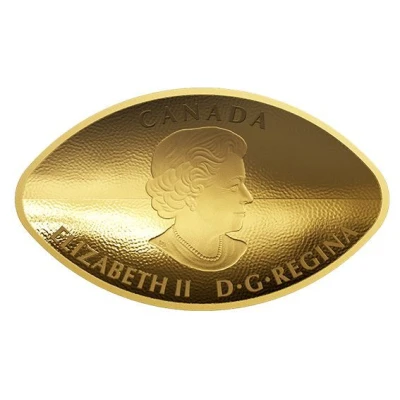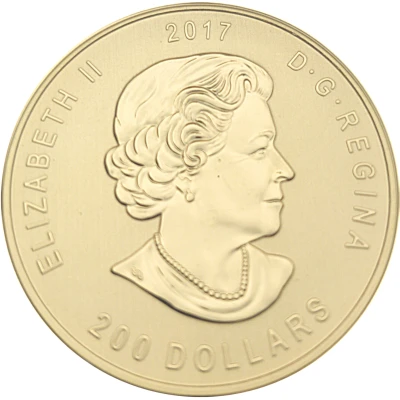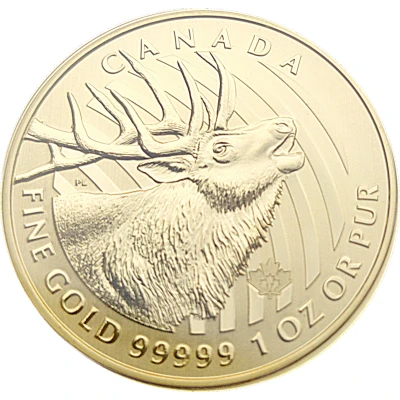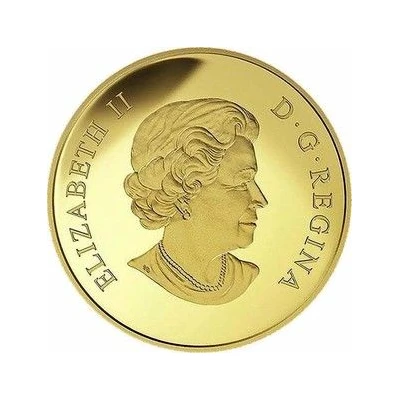
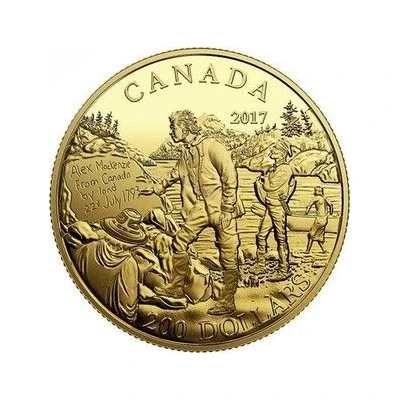

200 Dollars - Elizabeth II Alexander Mackenzie
2017 year| Gold (.9999) | 15.43 g | 29 mm |
| Issuer | Canada |
|---|---|
| Queen | Elizabeth II (1952-2022) |
| Type | Non-circulating coin |
| Year | 2017 |
| Value | 200 Dollars 200 CAD = USD 148 |
| Currency | Dollar (1858-date) |
| Composition | Gold (.9999) |
| Weight | 15.43 g |
| Diameter | 29 mm |
| Thickness | 1.6 mm |
| Shape | Round |
| Technique | Milled |
| Orientation | Medal alignment ↑↑ |
| Updated | 2024-10-04 |
| Numista | N#377983 |
|---|---|
| Rarity index | 100% |
Reverse
The piece, by Canadian artist John Mantha, is a full-length portrait of the great explorer Sir Alexander Mackenzie. Meticulously engraved in minute detail, the scene also shows his crew at the most westerly point of their expedition, on the majestic shore of a river surrounded by rocky headlands. In the distance, the waters of the Pacific seem to shimmer with golden reflections thanks to the piece's polished surface. In the foreground, Mackenzie stands on the shore in front of a large boulder, inscribed with the words "Alex Mackenzie from Canada by land 22D July 1793", proof of his passage and impressive journey. A guide from the Nuxalk nation, essential to the success of the expedition, can be seen from behind in the lower left of the coin, while to Mackenzie's right stand two other crew members, one of whom is helping to carry the dugout canoe loaned by the Nuxalks into the shallow waters. The entire motif of the piece is full of meticulous historical detail, particularly the appearance of the clothing worn by the voyageurs and the traditional cedar bark hat worn by the guide. This piece is undoubtedly a work of art that will forever immortalize a defining moment in Canadian history.
Script: Latin
Lettering:
CANADA
2017
200 DOLLARS
JM
Designer: John Mantha
Edge
Serrated
Comment
By the end of the 17th century, explorers and voyageur traders were making increasing inroads into Western Canada. La Vérendrye and his quest for the "Great Western Sea" had stimulated the expansion of the fur-trading network, but the overland route to the continent's west coast had yet to be discovered. According to historical records, Sir Alexander Mackenzie (1764-1820) was the first to achieve this feat: he reached the waters of the Pacific in July 1793, becoming the first European to cross the American continent north of Mexico. The publication of a book recounting his journeys to Canada's Arctic and Pacific coasts aroused great public interest and inspired others to follow in Mackenzie's footsteps, placing him alongside the greatest explorers in the country's history.Alexander Mackenzie's two remarkable expeditions took him further than anyone before into the largely unexplored territories of the Canadian West and Northwest. In 1789, on his first attempt, he surprisingly reached the Arctic Ocean by following a great river, which would later be named after him. In 1793, he headed west again in a birchbark canoe, accompanied by his cousin, two guides, six voyageur traders and a dog. Following the advice of the First Nations he met along the way, Mackenzie guided his crew along the Peace River, the Fraser River and the Bella Coola River, resorting to portaging when necessary.his determination ultimately led him to the waters of the Pacific, but he was forced to turn back before reaching the ocean itself - not without leaving a mark of his achievement by painting these few words on a rock:
Alex Mackenzie from Canada by land 22D July 1793.
Alex Mackenzie, from Canada by land, July 22, 1793.
Did you know?
Sir Alexander Mackenzie's journals, published in 1801 in a collection entitled Voyages from Montreal Through the Continent of North America to the Frozen and Pacific Oceans in 1789 and 1793, are said to have inspired U.S. President Thomas Jefferson, who commanded Lewis and Clark's famous expedition to the Pacific.
Mackenzie used a mixture of vermilion and bear fat to paint his message, but surveyors later helped preserve it by engraving it in rock. Today, visitors to Sir Alexander Mackenzie Provincial Park can admire the inscription at the site known as "Mackenzie's Rock", on the edge of the Dean Channel.
While Mackenzie led his expedition overland to North Bentinck Arm, George Vancouver explored the coast by sea. In fact, the latter's longboats had been sailing the river just 48 days before Mackenzie's arrival.
Part of the explorer's route to the Bella Coola Valley is preserved by the Alexander Mackenzie Heritage Trail. Long used by members of the Nuxalk Nation and the Porters who guided Mackenzie to his destination, this trail is nicknamed the "Grease Trail", as it links communities on the coast and the mainland, facilitating the trade of eulachon grease, also known as candlefish.
About Mackenzie
Born in Scotland in 1764, Alexander Mackenzie (1764-1820) crossed the Atlantic for the first time in 1774, when his widowed father decided to settle his family in New York. With the outbreak of the American Revolution, his father and brother joined the King's Royal Regiment of New York, and Mackenzie moved with his Loyalist family upstate, then further afield to the bustling center of North America's fur-trading network: Montreal.
While still a teenager, Mackenzie landed a job as a junior clerk at the Finlay and Gregory fur-trading company, where he excelled. He was offered a partnership, on one condition: he had to take charge of the Grand Portage trading post, which he did from 1785 until the company merged with the North West Company in 1787.
In the winter of 1787-1788, Mackenzie was assigned to a post on the Athabasca River in what is now northern Alberta, where he co-founded Fort Chipewyan. During this period, he learned a great deal from Peter Pond. Inspired by the stories told by the Dene, one of the First Nations, about a great river, Pond believed it to be a passageway to the West Coast.Mackenzie decided to put this theory to the test: in 1789, he assembled a small crew and set out on the Slave River, following it to Great Slave Lake before paddling the long river that would later bear his name. One day, the voyageurs realize they're heading north, not west. On July 14, 1789, they reached the mouth of the river, which empties into the Arctic Ocean, then turned around and returned to Fort Chipewyan.
Undaunted, Mackenzie obtained permission from the North West Company to prepare another expedition. On October 10, 1792, he set out on the Peace River with two native guides, his cousin, six travelling traders and a dog, wintering at Fort Fork before setting out again on May 9, 1793. Portaging south across the Rocky Mountains, Mackenzie followed the usual trade routes to the Fraser River, where the porters advised him to head west towards the Bella Coola Gorge. Borrowing canoes from the Nuxalks, he finally reached his goal in July: the North Bentinck Arm, where the Pacific Ocean flows.
Mackenzie thus enters history as the first European to cross the North American continent, in what is now Canada. The travelling party attempted to continue towards the ocean, but a hostile encounter with Heiltsuk warriors prevented them from doing so. Before setting off on his return journey, Mackenzie left a mark of his passage and his journey by painting on a rock, using a mixture of vermilion and bear grease: "Alex Mackenzie / from Canada by land / 22D July 1793" (Alex Mackenzie / depuis le Canada par voie terrestre / le 22 juillet 1793). To this day, the rock still bears this message.
Mackenzie's journals were published in 1801, in a collection entitled Voyages from Montreal Through the Continent of North America to the Frozen and Pacific Oceans in1789 and 1793. This publication earned him unanimous praise and a reputation as a talented explorer. Mackenzie was knighted in 1802 for his exploits. From 1804 to 1808, he sat in the Lower Canada House of Assembly, then returned to Scotland on retirement, where he married in 1812. Mackenzie succumbed to Bright's disease in 1820, aged 56.
Packaging
The coin is encapsulated and presented in a burgundy double-shell case featuring the Royal Canadian Mint logo. The case is accompanied by a black protective box.
Interesting fact
One interesting fact about the 2017 Canadian $200 Gold Coin (Elizabeth II - Alexander Mackenzie) is that it has a very low mintage of only 250 coins, making it a highly sought-after collector's item.
Price
| Date | Mintage | VG | F | VF | XF | AU | UNC |
|---|---|---|---|---|---|---|---|
| 2017 | 1000 | - | - | - | - | - | - |
Values in the table are based on evaluations by sales realized on Internet platforms. They serve as an indication only for 200 Dollars - Elizabeth II (Alexander Mackenzie) 2017 coin.
